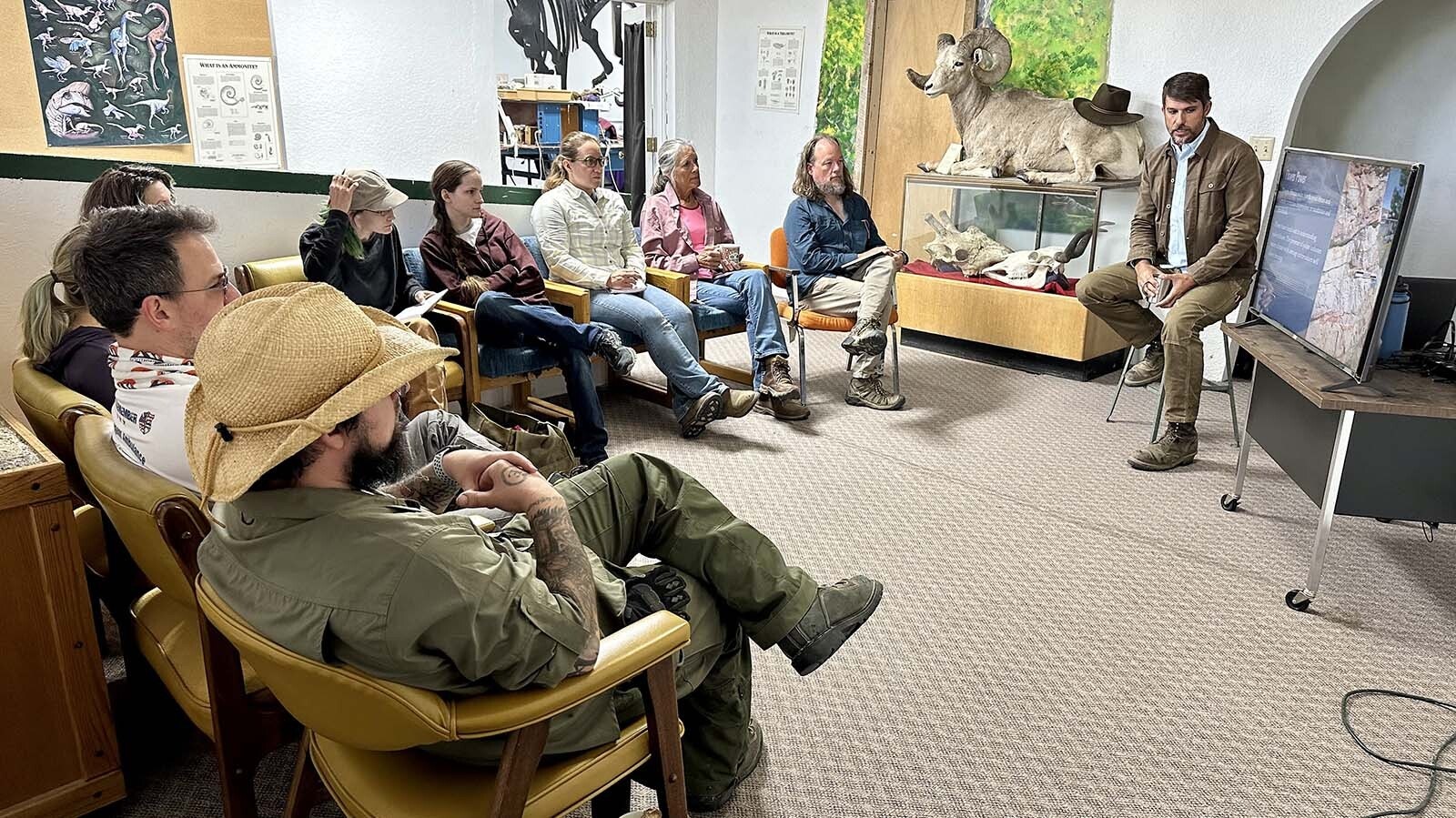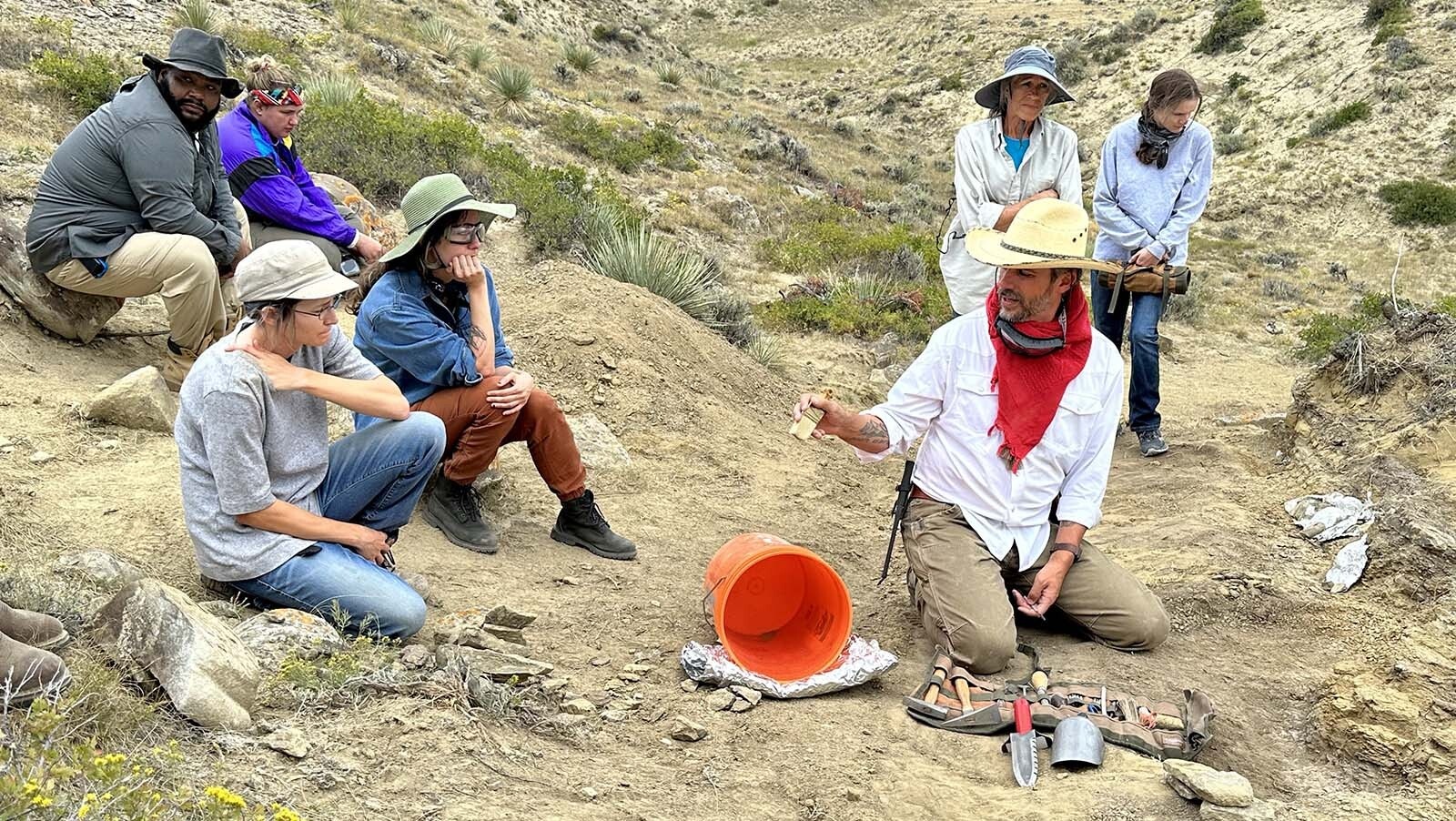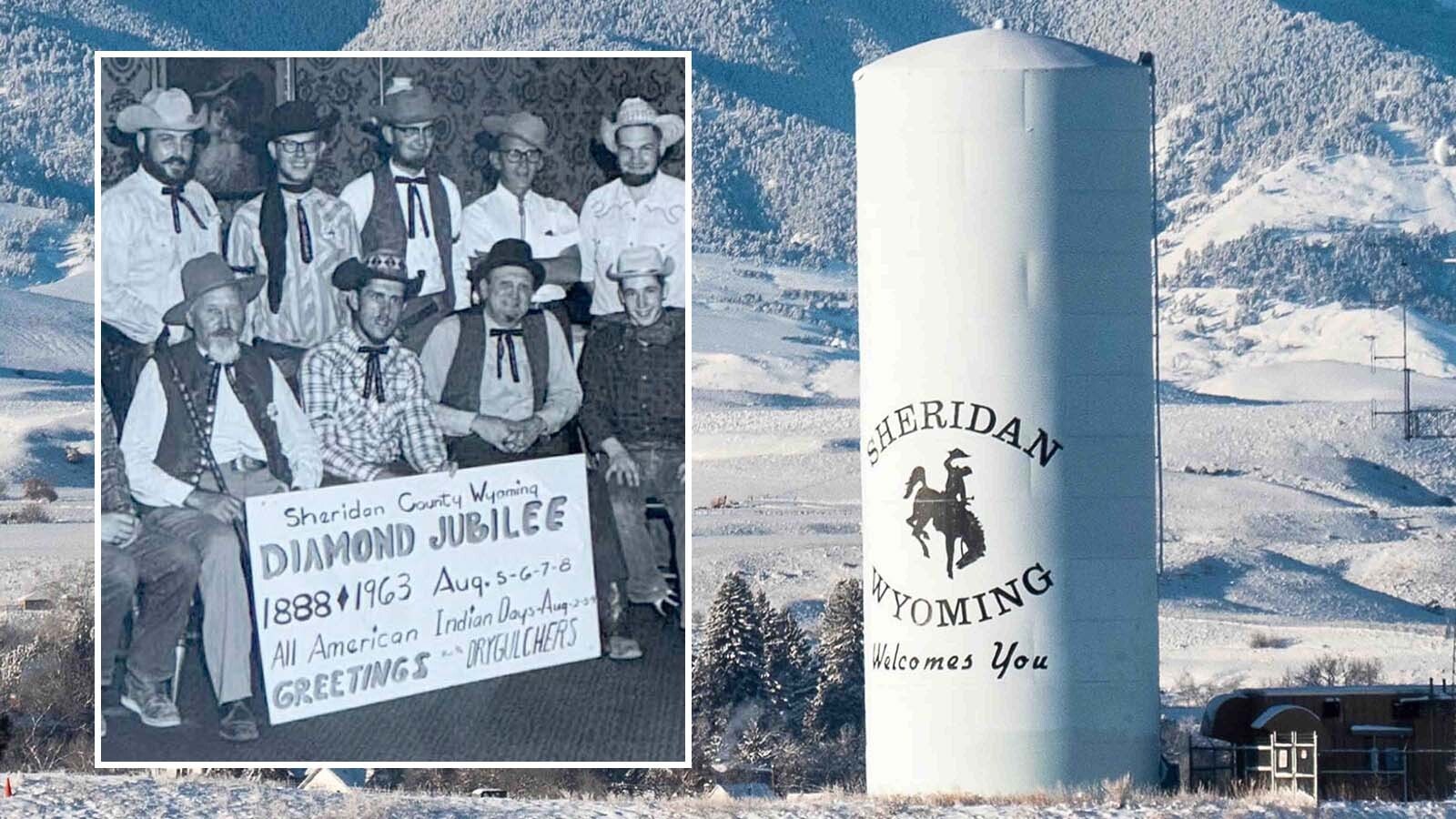GLENROCK — On the final day of August, 10 people gathered in the backroom of the Paleon Museum in downtown Glenrock. For the next three days, they would sit in the hot sun and particularly relentless Wyoming wind along the slopes of hills of Converse County for the next three days to find fossils.
They came to the Paleon for one of the summer field sessions of the Triceratops Gulch Project, a collaborative program between the Paleon and the Morrison Natural History Museum in Morrison, Colorado. The partnership was forged to strengthen both museums through new programs and scientific research.
Lori Sallenberger came to Glenrock from Pennsylvania to fulfill a long-simmering desire to go fossil hunting.
“I just wanted an overview of the whole process and a feel for what goes into finding fossils. And there’s always the hope you’ll find something exciting,” she said.
Lori’s daughter, Morgan, has a degree in geology and environmental science. She wanted to see something different than the pre-dinosaur fossils she was used to in the eastern United States.
Matthew Mossbrucker, the director of the Morrison Museum, has been leading the Triceratops Gulch Project since its inception in 2016. He tasked himself with making the three-day digging experience as instructive as possible.
“I’m here to harness your curiosity and deepen your appreciation of life, then and now,” he told the group.
Every morning started with presentations by Mossbrucker, discussing dinosaurs and the importance of the Triceratops Gulch Project in his unique cadence of soothing sarcasm. The goal was to share fascinating facts and history and equip each session’s citizen scientists with information they could use to enhance their field experience.
Over the next few days, each participant would make small discoveries that, when put together, would contribute to one of the most comprehensive paleontology projects to come out of Wyoming and the American West.

Days Of Discovery
Triceratops Gulch is a large swath of exposed rock on a private ranch near Glenrock. In 28 years of digging, over 70 sites have been identified along the expanse, containing everything from complete skeletons and massive skulls to micro-sites and plant impressions.
Appropriately enough, the first fossil found in Triceratops Gulch was a Triceratops skull. Christened Lady Stephanie, it became one of the centerpiece specimens of the Paleon, where it remains on exhibit to this day.
On the afternoon of the first day of fieldwork, one of the last scheduled for the summer, Mossbrucker and his field leaders guided the citizen scientists to their workspace: Site B.22.8, more affectionally named Stuart’s Site after the Paleon’s board president Stuart McCrary. The site was particularly exciting because it preserved large bones in addition to tiny fossils being collected for the project.
Dental picks and makeup brushes are the tools used when millimeters of rock can make a difference. Within a few hours, everyone had their noses within a few inches of the ground to better see their spot and watch as tiny fossils slowly revealed themselves. Every fossil or rock of interest was placed on an orange cafeteria tray for identification.
“It’s different from digging big bones. Here, there’s a constant thrill of discovery,” said Daniel Alan Solomon, an adjunct professor of anthropology at De Anza College in Cupertino, California
Solomon was enjoying his eighth session at Triceratops Gulch. He’s in the process of researching public paleontology programs for a book, but he keeps coming back because he likes contributing to the bigger picture. Plus, it's so much fun.
“The diggers are contributing to actual research projects. It’s wish fulfillment as well. I love dinosaurs. To see the bits come out of the ground is really thrilling,” he said.

They’re How Old?
Nearly all the sites in Triceratops Gulch are in the Lance Formation from roughly 67 million years ago. The contemporaneous Hell Creek Formation spread throughout Montana and South Dakota, easily the most famous fossil formation in the world, often overshadows the nearly Wyoming-exclusive Lance Formation.
Together, both layers preserve the last days of the Age of Dinosaurs and the fossils of its inhabitants like Triceratops and Tyrannosaurus rex.
Solomon has a knack for finding fossils and impressions of plants from the Lance Formation. One of the sites in the area is named “Danny’s Forest” after he found a site containing several plant impressions.
The only person who wasn’t actively digging in Stuart’s Site was Mossbrucker. In addition to answering questions and identifying fossils, he recorded important information on the site and every fossil that was unearthed.
“You get to be my hands in the quarry while I write things on baggies and write in journals and look stressed out,” Mossbrucker said as he oversaw the first day of digging.
When Mossbrucker started the Triceratops Gulch project, he had the same preconceptions as everyone who worked in Lance Formation: most fossils are from Triceratops, and everything else is rare.
After six years, the discoveries of the Triceratops Gulch Project have profoundly changed his interpretation of the Lance Formation’s paleoenvironment. Stuart’s Site, in particular, has been a game-changer because of many new fossils with enormous scientific significance.
“New creatures have come to life that I’ve never seen before. It’s like a good detective story,” he said.

The Tooth Of The Matter
Each day of excavation ended with everyone getting their tray looked over by Mossbrucker, who identified nearly every fossil discovered. If he couldn’t positively identify a fossil, it became even more exciting.
Hundreds of fossils were found representing dozens of prehistoric animals: gar scales, bones from the skulls of fish, pieces of turtle shell, teeth from crocodiles and a “false crocodile” called Champosaurus, a possible salamander jaw, and “osteogastroliths,” tiny fragments of bone that were swallowed and smoothed out in the stomachs of whatever swallowed them.
And there were plenty of dinosaur fossils. The most common dinosaur finds were teeth from Triceratops and Edmontosaurus, but there were also teeth from large and small dromaeosaurs, relatives of the famous Velociraptor. Large bones were discovered, including a theropod toe bone, possibly from an ostrich-like Struthiomimus, and the bottom end of a dinosaur femur.
Sallenberger found the theropod toe bone, which quickly became her favorite discovery of the program. Morgan’s hard work paid off on the final day when she found a post-cerebral vertebra of a medium-sized theropod.
Solomon’s green thumb for fossil plants again proved helpful when he found a plant impression near Stuart’s Site. Mossbrucker identified it as a prehistoric lily pad, something he’d rarely seen in the Lance or Hell Creek Formations.
Solomon also spent a day digging through “the spoil pile,” where diggers dump their buckets of excavated rock. The spoil pile is searched for anything that may have been overlooked and is often just as exciting as the site itself.
“I found fish, reptiles, dinosaurs, a piece of a crocodile vertebra (in the spoil pile.) The alternative is working on one big leg bone for a week. And that’s cool. Big bones are cool. Everybody wants to find a big honking dinosaur. But if you’re working in the microsites, you get discovery after discovery after discovery. It’s always little different bits of things. It’s a thrill to keep coming up with something,” he said.
Even the Tyrant Lizard King deigned to make an appearance. While certainly not the rarest fossil, the whole team felt rewarded when a T.rex tooth emerged from the site (which was proudly discovered by the author of this article.)

Glorious Accidents
“Discovery is a glorious accident,” Mossbrucker said frequently through the program. There have been many glorious accidents in the Triceratops Gulch Project, but the ongoing effort to scientifically analyze the fossil finds is the most deliberate in the history of the Paleon Museum.
While citizen scientists enjoy the thrill of discovery in the field, Mossbrucker continuously experiences it in the lab as he and his colleagues identify and analyze the fossils collected during the summer programs. The Triceratops Gulch Project may be the most thorough micro-site research project ever undertaken in the Lance Formation or possibly any fossil formation. And it’s paying off in spades.
Teeth make the difference. Every tooth is diagnostic, meaning it can be positively identified as coming from a specific animal. Thousands of teeth have been excavated and identified, which has presented new patterns that could make every paleontologist check their collections to see if specimens could be misidentified.
The fossils found through the project suggest incredible theories about the world of the Late Cretaceous in the American West. Mossbrucker and his team have evidence that could solve the paleontology equivalent of identity theft, cold cases, and personality profiles that shake up the primeval politics of a T.rex-dominated food chain.
It’s already happening. Several teeth on display at the Paleon for decades have been scrutinized and reidentified because of the discoveries of the Triceratops Gulch Project.
These discoveries could permanently change the paleontological interpretation of the Lance and Hell Creek Formations and prove some of the most contentious claims about the most studied fossil formation in the world.
But not yet.

Finding It Is Just The Beginning
While these earth-shaking fossils have been discovered, there’s still much research and writing to do before the discoveries can be released to the scrutiny of paleontologists. Now, for the first time since the project began, enough evidence has been found for some of these theories to be published and presented to the world.
One tooth usually isn’t enough to prove anything. A dozen teeth make a compelling enough case to publish.
Once these discoveries are published, all eyes in the paleontological world will turn toward Glenrock. The research could inspire arduous debates, but Mossbrucker is confident the fossils support the science.
“One observed fact is worth any amount of expert opinion,” he said as his adopted mantra for paleontology.
As the final day concluded, there was a reluctance to leave Stuart’s Site. Everyone had found something significant, and the site was more exciting than when they found it, with newly discovered large bones exposed.
By the final day, nearly everyone could recognize when they found a fossil and even make a tentative identification. Everyone also realized how much more was waiting to be unearthed, but that would have to wait for the next group of participants.
“This project is as much about science literacy as ‘dinosaur digging.’ We simply endeavor to do the field and these animals justice,” Mossbrucker said.
Solomon intends to keep participating in the Triceratops Gulch Project, both for his research and enjoyment. Every session brings the joy of discovery and a new group of people from all walks of life vacationing in the prehistoric past.
“As a layman in this field, I get to contribute to something that’s fascinated me for my entire life. And I meet super-cool people every time. The packs we end up with are such interesting people from so many fields, different forms of expertise, personalities, and places around the world. It’s the highlight of my year every year,” he said.
As dramatic as the scientific implications of the Triceratops Gulch Project may be, Solomon believes the greatest benefit of the ongoing program is the scientific literacy it brings to its participants.
For a few days, everybody lived in the world of Wyoming 67 million years ago. They come away from the experience with a new awareness of the state and the science that leaves a permanent mark, much like the fossils themselves.
“There’s paleontological importance, but I think stuff like this in the public eye is an ethical treasure,” he said. “Not everyone needs the skills to dig up dinosaur bones, but the ethical treasure of the awareness of the scope of time and our position in the living world is priceless.”
Andrew Rossi can be reached at arossi@cowboystatedaily.com.





